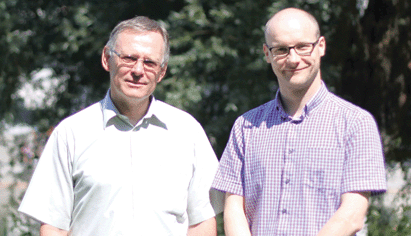Frontiers in Molecular Main Group Chemistry: a web themed issue
Manfred
Scheer
a and
Richard A.
Layfield
ab
aInstitute of Inorganic Chemistry, University of Regensburg, Universitaets str. 31, 93053, Regensburg, Germany. E-mail: manfred.scheer@chemie.uni-regensburg.de
bSchool of Chemistry, The University of Manchester, Manchester, M13 9PL, UK. E-mail: richard.layfield@manchester.ac.uk
 Manfred Scheer and Richard A. Layfield | Manfred Scheer received his PhD at the University of Halle-Wittenberg, 1983. After research at the Russian Academy of Sciences in Novosibirsk and the Max-Planck-Institute in Mülheim/R., he habilitated in Halle/S. Promoted by a Feodor Lynen Fellowship of the Alexander von Humboldt Foundation he was guest professor at Indiana University in Bloomington. He was a Heisenberg Fellow of the German Research Council at the University of Karlsruhe and became Associated Professor in 1996. In 2004 he became Chair of Inorganic Chemistry at the University of Regensburg. In 2012 he was awarded an honorary doctorate of the Russian Academy of Sciences. |
Dr Richard A. Layfield was born in Leeds, Great Britain. Following undergraduate studies at the University of Leeds (1999), he obtained his PhD at the University of Cambridge (2002). After spells as a Junior Research Fellow and fixed-term Lecturer in Cambridge, he was appointed to a Lectureship in Inorganic Chemistry at The University of Manchester in 2007. He was awarded the RSC's Meldola Medal in 2006 and he is a recipient of a Fellowship for Experienced Researchers from the Alexander von Humboldt Foundation, which is held at the University of Regensburg, Germany. |
It is with great pleasure that we welcome colleagues to the ChemComm web themed issue Frontiers in Molecular Main Group Chemistry. ChemComm's longstanding tradition of showcasing the diversity of Main Group inorganic and organometallic chemistry is encapsulated within our web themed edition, with this collection of reviews and communications featuring a broad range of cutting-edge chemistry based on the s-block and p-block elements.
The responses received from those invited to contribute was extremely enthusiastic, resulting in too many articles to allow each to be mentioned in detail. The content of the special issue reflects a number of important trends in modern Main Group chemistry. Communications from Aldridge, Goicoechea, Tilley and Weller, a collaboration from Hissler, Crassous and Réau, and a feature article by Wright, describe exciting results at the interface between Main Group and transition metal organometallic chemistry. Novel applications of s-block metals in catalysis and organic synthesis are featured in communications from Hevia, Hill, Strohmann and Westerhausen.
As expected, certain Main Group elements feature particularly prominently. Several articles are devoted to the chemistry of boron, from Himmel, Ingleson, Jäkle, Liddle and Wagner. The chemistry of silicon is covered in communications from Rivard, Scheschkewitz and from H. W. Roesky and co-workers. Phosphorus features in a review by H. W. Roesky, and in communications from Bourissou, Burford, Streubel and Tokitoh. The chemistry of the heavier Group 14 elements is showcased in communications from Breher, Fässler, Jones, Sevov and von Hänisch. A review on polyimido sulfur anions and ylides by Stalke and a communication by Chivers and Woollins on phosphorus–sulfur and phosphorus–selenium macrocycles represent Group 16.
When the idea of a special issue devoted to modern Main Group chemistry was conceived in 2011, our aim was to collect a series of articles that reflects the vibrancy of this perennially fascinating field. With the help of the corresponding authors for each article and – crucially – the hard work of their students and post-docs, we are confident that we have been able to achieve this aim. Mindful of the traditional purpose of a communication-style article, we look forward to watching the Frontiers in Molecular Main Group Chemistry evolve into more extensive investigations.
| This journal is © The Royal Society of Chemistry 2012 |
